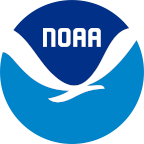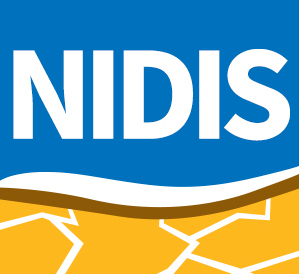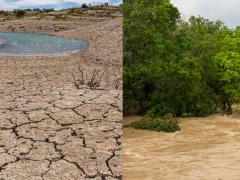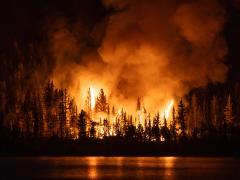Submit Abstracts for Drought Sessions at the 106th AMS Annual Meeting
The American Meteorological Society (AMS) is hosting its 106th annual meeting on January 25–29, 2026, in Houston, Texas. This year, the meeting will focus on the theme, “Fast and Slow Thinking: The Human Factor in a Rapidly Changing World.”
NOAA’s National Integrated Drought Information System (NIDIS) and partners are proud to be involved in the 2026 AMS Annual Meeting. This year, Midwest Drought Early Warning System Coordinator Molly Woloszyn is one of the Program Committee Chairs for the 40th Conference on Hydrology, and NIDIS Program Manager Meredith Muth serves on the AMS Board on Enterprise Decision Support.
The call for abstracts is now open, and the abstract submission deadline for most sessions was extended to Thursday, August 21, 2025 at 5 p.m. ET. AMS is also accepting applications for delayed payment of abstract submission fees.
Below, explore a selection of drought-related sessions accepting abstracts for next year’s meeting:
Advancements in Drought Prediction and Analysis
Effective drought early warning of sector-specific impacts related to too little water are based on proactive responses made possible by accurate and reliable drought predictions. We therefore invite submissions that advance our ability to predict and understand the complex interactions between terrestrial, atmospheric, and oceanic processes that can be used to anticipate drought and its effects, particularly during its onset and demise phases. Specific topics addressed by presenters could include, but are not limited to: introduction of drought forecast frameworks; prediction skill assessments of drought forecasts; physical process assessments of drought forecasts; transitions of drought forecasts to operations; communication of drought forecasts to the public.
Advancements in Drought Monitoring and Analysis
Drought is a multi-faceted phenomenon that challenges our current monitoring capabilities, yet its environmental and economic consequences are among the most serious of all natural disasters. Improving monitoring of all drought types requires the use of multiple data sources, including in situ and remote-sensing data, surface observations, and models. Satellite hydrological and vegetation indices have contributed dramatically to our understanding of the mechanisms of drought occurrence and development, while facilitating the separation of the drought signal from normal hydrologic and vegetation conditions. However, making significant improvements in monitoring will not only require advances in understanding drought mechanisms, but also of the societal impacts and how to better manage water resources. There are still many open scientific questions related to data fusion, integration of drought indicators, emerging social media data sources, and the optimal combination of these datasets for providing insights to climate, environmental security, and societal changes with respect to drought events. Addressing these outstanding challenges related to drought monitoring directly aligns with this year’s AMS Meeting Theme of “Fast and Slow Thinking: The Human Factor in a Rapidly Changing World.”
Specific topics addressed by presenters could include, but are not limited to: current drought monitoring science; advances in our understanding of the causes and characteristics of drought, including flash drought; drought development associated with land-atmosphere interactions and vegetation dynamics; innovative management uses of drought science; and case studies illustrating advances in monitoring drought and drought impacts. Further, papers identifying and/or addressing gaps and deficiencies in our current methods for monitoring droughts and estimating drought’s effects on vegetation, water and energy resources, environmental security, and the health and food security of human populations are also invited.
Drought: Mechanisms and Impacts in the Past, Present, and Future
Understanding the interacting factors that produce droughts is crucial to preparing for their impacts and managing them when they occur. This session focuses on work that improves our understanding of the interactions that cause drought, and their cascading physical effects, through analysis of observations (including paleoclimate) and/or Earth System Model simulations. In particular, we invite work that aims to improve our understanding of the role of feedback processes in initiating, sustaining, or ending drought, and links to the physical impacts of drought including snowpack, water availability, heatwaves, and wildfire. In addition, we welcome contributions focused on spatiotemporal variability of drought, predictability, and societal impacts.
Land Use, Drought, and Water Stress: Informing Agricultural Food Security and Early Warning
Global food and water security face increasing pressure from climate variability, coupled with significant anthropogenic modifications of the land surface. This session focuses on the critical intersections between hydro-climatic extremes, a spectrum of land management practices (influencing water use, nutrient cycling, and cropping system design), and their impacts on agricultural systems and food security monitoring. This includes, for example, studies of irrigation as both a critical but potentially limited adaptation strategy and as a factor influencing local-to-regional hydroclimate and water availability, as well as studies exploring drought impacts and related feedbacks within diverse natural and human-modified ecosystems, including those employing practices like conservation tillage, crop rotation, or agroforestry. Integrating these physical drivers and management choices, and understanding the consequent land-water-atmosphere feedbacks, is crucial for assessing impacts on farming systems, crop yields, and overall agricultural resilience. We particularly welcome research that utilizes observational datasets (remote sensing and in situ), advanced modeling techniques (hydrological, atmospheric, crop models), and data assimilation approaches.
For more information, please contact Molly Woloszyn (molly.woloszyn@noaa.gov).



